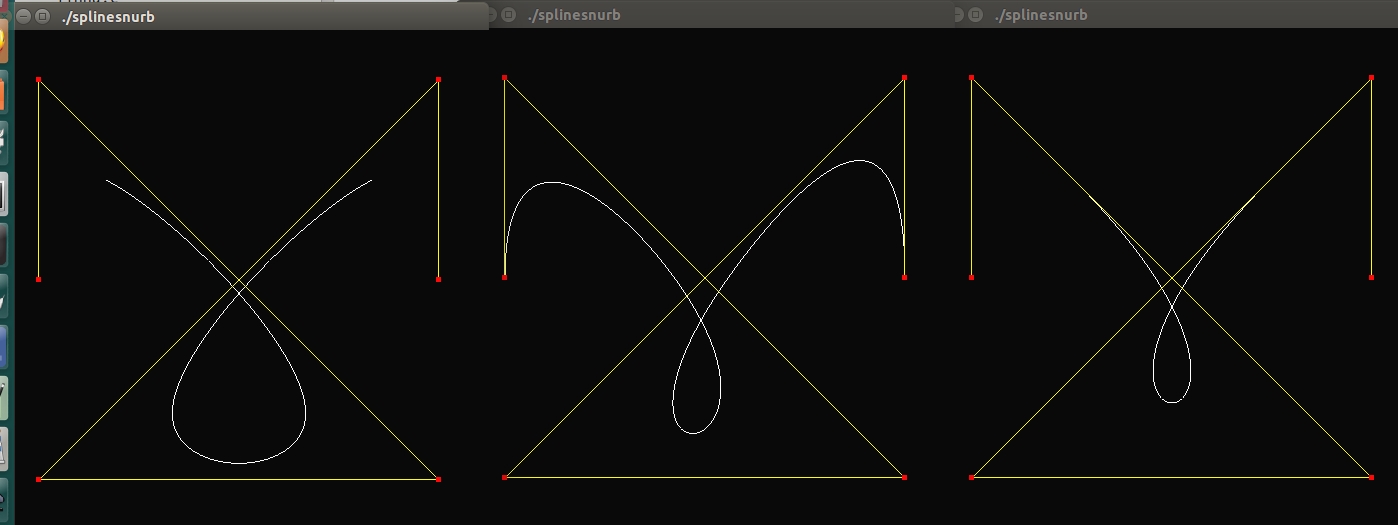Exercícios
Utilizando o programa exemplos/splines2d.c como referência, implemente um programa splinesnurbs.c. Quando a tecla u for pressionada, a NURBS deverá ser desenhada utilizando um vetor de nós uniforme. Quando a tecla o for pressionada, a NURBS deverá ser desenhada utilizando um vetor de nós uniforme aberto. Quando a tecla n for pressionada, a NURBS deverá ser desenhada utilizando um vetor de nós não uniforme.
Código
#include <stdlib.h>
#include <GL/glut.h>
#include <math.h>
GLint nVertices=6;
GLfloat vertices[6][3] = {
{-4.0, 0.0, 0.0},
{-4.0, +4.0, 0.0},
{+4.0, -4.0, 0.0},
{-4.0, -4.0, 0.0},
{+4.0, +4.0, 0.0},
{+4.0, 0.0, 0.0}
};
GLint largura, altura;
GLint mudaCurva=0;
GLint verticeCorrente=0;
GLfloat esquerda=-5;
GLfloat direita =+5;
GLfloat fundo =-5;
GLfloat topo =+5;
GLfloat longe =+5;
GLfloat perto =-5;
enum {NURBS, NURBSU, NURBSUA};
GLint spline;
GLUnurbsObj *nc;
GLfloat nos[10]={0.0, 0.0, 0.0, 0.0, 1.0, 2.5, 3.0, 3.0, 3.0, 3.0};
GLfloat nos1[10]={0.0, 0.3, 0.6, 0.9, 1.2, 1.5, 1.8, 2.1, 2.4, 2.9};
GLfloat nos2[10]={0.0, 0.0, 0.5, 1.0, 1.0, 2.5, 2.5, 3.0, 3.0, 3.0};
GLint nNos=10;
GLint matrizViewport[4];
GLdouble matrizModelview[16], matrizProjecao[16];
GLint yreal; /* posição da coordenada y no OpenGL */
GLdouble wx, wy, wz; /* coordenadas no mundo real: x, y, z */
void display(void){
int i;
glClear(GL_COLOR_BUFFER_BIT);
switch(spline){
case NURBS:
gluBeginCurve(nc);
gluNurbsCurve(nc, nNos, nos2, 3, &vertices[0][0], 4, GL_MAP1_VERTEX_3);
gluEndCurve(nc);
break;
case NURBSU:
gluBeginCurve(nc);
gluNurbsCurve(nc, nNos, nos1, 3, &vertices[0][0], 4, GL_MAP1_VERTEX_3);
gluEndCurve(nc);
break;
case NURBSUA:
gluBeginCurve(nc);
gluNurbsCurve(nc, nNos, nos, 3, &vertices[0][0], 4, GL_MAP1_VERTEX_3);
gluEndCurve(nc);
break;
}
glPointSize(5.0);
glColor3f(1.0, 1.0, 0.0);
glBegin(GL_LINE_STRIP);
for (i = 0; i < nVertices; i++)
glVertex3fv(&vertices[i][0]);
glEnd();
glColor3f(1.0, 0.0, 0.0);
glBegin(GL_POINTS);
for (i = 0; i < nVertices; i++)
glVertex3fv(&vertices[i][0]);
glEnd();
glColor3f(1.0, 1.0, 1.0);
glFlush();
glutSwapBuffers();
}
void init(void){
glClearColor(0.0, 0.0, 0.0, 0.0);
spline=NURBS;
nc= gluNewNurbsRenderer();
gluNurbsProperty(nc, GLU_SAMPLING_TOLERANCE, 5.0);
glEnable(GL_MAP1_VERTEX_3);
display();
}
void reshape(int w, int h)
{
glViewport(0, 0, (GLsizei) w, (GLsizei) h);
glMatrixMode(GL_PROJECTION);
largura=w;
altura=h;
glLoadIdentity();
glOrtho(esquerda,direita, fundo, topo, perto, longe);
glMatrixMode(GL_MODELVIEW);
glGetIntegerv(GL_VIEWPORT, matrizViewport);
glGetDoublev(GL_MODELVIEW_MATRIX, matrizModelview);
glGetDoublev(GL_PROJECTION_MATRIX, matrizProjecao);
glLoadIdentity();
glutSwapBuffers();
}
/* ARGSUSED1 */
void keyboard(unsigned char key, int x, int y)
{
switch (key) {
case 'n'://não uniforme
spline = NURBS;
glutPostRedisplay();
break;
case 'u'://uniforme se os nós são singulares, não repetidos e espaçados com mesmo tamanho
spline = NURBSU;
glutPostRedisplay();
break;
case 'o':/*uniforme aberto The
knot sequence has a multiplicity of 4 at the beginning and end, which causes the curve to pass through the first
and last control points*/
spline = NURBSUA;
glutPostRedisplay();
break;
case 27:
exit(0);
break;
}
}
void proximidade(){
int i;
double tam=0, tamin=32000;
verticeCorrente=0;
for(i=0; i<nVertices; i++){
tam = (wx-vertices[i][0])*(wx-vertices[i][0])+
(wy-vertices[i][1])*(wy-vertices[i][1]);
if(tam < tamin){
tamin=tam;
verticeCorrente=i;
}
}
tamin=sqrt(tamin);
if(tamin > 0.5){
mudaCurva=0;
}
}
void mouse(int button, int state, int x, int y){
switch (button) {
case GLUT_LEFT_BUTTON:
if (state == GLUT_DOWN) {
yreal = matrizViewport[3] - (GLint) y - 1;
gluUnProject ((GLdouble) x, (GLdouble) yreal, 0.0,
matrizModelview, matrizProjecao, matrizViewport,
&wx, &wy, &wz);
mudaCurva=1;
proximidade();
}
if (state == GLUT_UP) {
mudaCurva=0;
}
break;
}
}
void motion(int x, int y){
if(mudaCurva){
yreal = matrizViewport[3] - (GLint) y - 1;
gluUnProject ((GLdouble) x, (GLdouble) yreal, 0.0,
matrizModelview, matrizProjecao, matrizViewport,
&wx, &wy, &wz);
vertices[verticeCorrente][0]=wx;
vertices[verticeCorrente][1]=wy;
glutPostRedisplay();
}
}
int main(int argc, char** argv){
glutInit(&argc, argv);
glutInitDisplayMode(GLUT_DOUBLE | GLUT_RGB);
glutInitWindowSize(500, 500);
glutInitWindowPosition(100, 100);
glutCreateWindow(argv[0]);
init();
glutDisplayFunc(display);
glutReshapeFunc(reshape);
glutKeyboardFunc(keyboard);
glutMotionFunc(motion);
glutMouseFunc(mouse);
glutMainLoop();
return 0;
}
Figure 1. Resultados